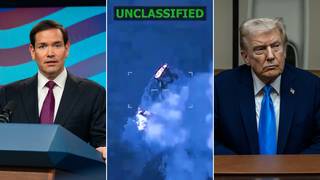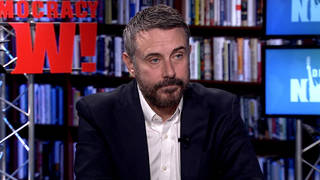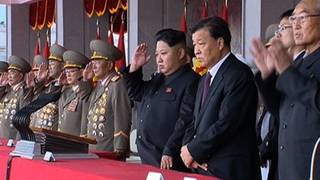
Guests
- Bruce Cumingsprofessor of history at the University of Chicago. His recent piece for The Nation is headlined “This Is What’s Really Behind North Korea’s Nuclear Provocations.” He is the author of several books on Korea, including Korea’s Place in the Sun: A Modern History and North Korea: Another Country.
- Christine Hongassociate professor at University of California, Santa Cruz, and an executive board member of the Korea Policy Institute. She has spent time in North Korea, including a visit to the country as part of a North American peace delegation.
Vice President Mike Pence has made an unannounced visit to the Demilitarized Zone separating South and North Korea, following North Korea’s attempted missile launch and a massive military parade celebrating the birthday of the country’s founder on Saturday. Pence’s visit comes at a time when tension between the United States and North Korea is quickly ratcheting up. A U.S. armada, including an aircraft carrier and multiple warships, has been deployed to the Korean Peninsula. Last week, NBC News reported the Trump administration is prepared to launch a preemptive attack on North Korea if it proceeds toward a nuclear weapons test. Hours before Pence arrived in South Korea, North Korea attempted to test launch a new ballistic missile, but the test failed as the missile blew up almost immediately.
Transcript
JUAN GONZÁLEZ: Vice President Mike Pence has made an unannounced visit to the Demilitarized Zone separating South and North Korea. Speaking at the border, Pence warned that the era of strategic patience with North Korea is over and that all options are on the table.
VICE PRESIDENT MIKE PENCE: Just in the past two weeks, the world witnessed the strength and resolve of our new president in actions taken in Syria and Afghanistan. North Korea would do well not to test his resolve or the strength of the armed forces of the United States in this region.
AMY GOODMAN: Vice President Pence’s visit comes at a time when tension between the United States and North Korea is quickly ratcheting up. Last week, NBC News reported the Trump administration is prepared to launch a preemptive attack on North Korea if it proceeds towards a nuclear weapons test. Hours before Pence arrived in South Korea, North Korea attempted to test launch a new ballistic missile, but the test failed as the missile blew up almost immediately.
JUAN GONZÁLEZ: It’s unclear if the U.S. had any role in the missile’s failure. According to The New York Times, the U.S. has a covert program to sabotage North Korea’s missile program using cyber and electronic strikes. During his trip to North Korea, Pence also announced the U.S. would move ahead with deploying the THAAD missile defense system in South Korea, despite opposition by China. This comes as China is urging the United States and North Korea to de-escalate the conflict.
LU KANG: [translated] We have reiterated many times that the situation on the peninsula is highly sensitive, complex and risky. We have always insisted that parties concerned should exercise restraint and refrain from mutual provocation and stimulating moves, and should dedicate themselves to efforts that will help reduce the current tension on the peninsula, so as to create the necessary conditions for them to come back to the table and resolve the Korean Peninsula issue in a peaceful way.
AMY GOODMAN: To talk more about North Korea, we’re joined by two guests. In Chicago, Bruce Cumings, professor of history at University of Chicago. His recent piece for The Nation headlined “This Is What’s Really Behind North Korea’s Nuclear Provocations.” He’s the author of several books on Korea, including Korea’s Place in the Sun: A Modern History and North Korea: Another Country. And joining us by Democracy Now! video stream, Christine Hong, associate professor at University of California, Santa Cruz, executive board member of the Korea Policy Institute. She’s spent time in North Korea, including a visit to the country as part of a North American peace delegation.
Professor Hong, let’s begin with you. The significance of what’s taken place in the last few days, starting with today, the surprise visit of Vice President Pence to the Demilitarized Zone?
CHRISTINE HONG: You know, I think what we’re witness to is a kind of revisionism, both with Vice President Pence and Secretary of State Tillerson. They’ve made comments that Obama’s policy of strategic patience is a thing of the past. And I think that that fundamentally misconstrues what the nature of strategic patience was. You know, as you mentioned in your opening description, Obama waged a campaign of cyberwarfare against North Korea. And so, you know, far from being a kind of kinder, gentler or even softer policy toward North Korea, Obama’s policy toward North Korea was, in point of fact, one of warfare.
The other thing that I would mention with regard to this is, even the possibility of military action against North Korea, a military option, if you will, that’s—that was—it would be inconceivable, if the Obama administration hadn’t made the militarization of the larger Asia-Pacific region one of its topmost foreign policy objectives. And under the Obama strategic pivot to the Asia-Pacific region, the U.S. concentrated its naval forces to a tune of 60 percent—to 40 percent in the Atlantic—in the Pacific region.
And so, you know, right now we have the situation in which the [Trump] administration is stating that all options are on the table. And I would want to remind your listeners and viewers that the United States performs the largest war games in the world with its South Korean ally twice annually. And in the course of performing these military exercises, it actually rehearses a number of things. It rehearses the decapitation of the North Korean leadership, the invasion and occupation of North Korea, and it also performs a nuclear first strike against North Korea with dummy munitions. And so, we have as one of the possibilities a nuclear—a preemptive nuclear strike against North Korea. That is the nature of the unhinged foreign policy that we’re seeing on the part of the Trump administration.
I would also say that even though North Korea and Kim Jong-un serves as a convenient foil, a kind of bad guy for U.S. foreign policy within the larger Asia-Pacific region, we have plenty of reason to be frightened of Donald Trump’s America-first foreign policy, which doesn’t serve Americans, much less anyone else around the world.
JUAN GONZÁLEZ: Bruce Cumings, professor of history at the University of Chicago, you have raised the issue that the media treats every—every crisis with Korea separate and apart from the previous crises that have occurred. Could you talk about that?
BRUCE CUMINGS: Well, that’s right. It’s not only that, but each crisis is treated as if it has really no background. The fact is that American nuclear intimidation of North Korea goes back to the Korean War. After the Korean War, in 1958, we installed hundreds of nuclear weapons in the south, the first country to bring nuclear weapons onto the peninsula. And North Korea has, essentially, since the late 1950s, had to find a way to deter the U.S. from using those weapons. For decades, they built underground. They have something like 15,000 underground facilities of a national security nature. But it was inevitable that when threatened with nuclear weapons—and Chris is right: President Obama threatened North Korea with nuclear weapons many times by sending B-2 bombers over the south, dropping dummy bombs on islands and so on. It was just inevitable that North Korea would seek a deterrent.
And what is, to me, so insane about this—particularly this last weekend, when somebody purposely leaked to NBC that the U.S. was considering a preemptive strike, but what’s so terrible about it is that you essentially get a standoff, with North Korea having nuclear weapons, the U.S. having nuclear weapons, but North Korea not being able to use them anywhere without being turned into a charcoal briquette. That was General Colin Powell’s reference to what would happen if North Korea launched a nuclear weapon in anger. So, somehow, I think the Trump administration quite purposely ratcheted up the tension. A week ago it was talk of assassinating Kim Jong-un; this weekend, talk of a preventive strike. I don’t think Vice President Pence is right that what President Trump has done shows strength and resolve. It’s one of the easiest things to fling 59 cruise missiles into Syria. Apparently, the military has wanted to test this MOAB, “Mother of All Bombs,” for some time, and it went ahead and did it. It’s not clear what the outcome of either strike is. And it seems that Mr. Trump, who ran on an anti-interventionist platform, is actually enjoying the toys that the military can provide to him, and perhaps using them in Korea, which would be a complete disaster.
JUAN GONZÁLEZ: Bruce Cumings, I wanted to ask you again about the historical record here. A lot of people forget the severe crises that have occurred between the United States and North Korea over the years. Back in 1968, for example, Korea seized the Pueblo, which was a surveillance ship right off its shores, and held more than 80 U.S. sailors prisoner for a year, before the United States apologized as part of a settlement. And a year later, in 1969, North Korea shot down a U.S. surveillance aircraft, where more than 30, I think, U.S. Air Force members were killed in that—in that incident. So there’s been a historical brinksmanship situation between the United States and North Korea, especially with the U.S. constantly, as Christine Hong said, displaying aggressive military actions and surveillance over North Korea.
BRUCE CUMINGS: Well, that’s right. I actually was in Seoul when that—when the Pueblo was seized in January of 1968. I was in the Peace Corps at that time. That created an enormous crisis. Lyndon Johnson wanted to hit North Korea in retaliation, but was informed that our bombers in South Korean bases, our bases in South Korea, only had nuclear weapons.
But I think the crisis that most clearly resembles the one over the weekend, or the one we’re in the middle of now, is in June 1994, when Bill Clinton nearly launched a preemptive strike at the Yongbyon plutonium facility. You may remember that former President Jimmy Carter flew to Pyongyang, had a discussion with Kim Il-sung, and out of that came an 8-year freeze on all of North Korea’s plutonium.
So, an easy way to solve this problem would be to revive direct talks with North Korea, normalize relations with North Korea, assure them that we don’t plan to attack them, and, just through those means, bring down the really terrible tension that existed over the weekend.
AMY GOODMAN: Well, during his trip to South Korea, Vice President Pence announced the U.S. would move ahead with deploying the THAAD missile defense system in South Korea, despite opposition by China.
VICE PRESIDENT MIKE PENCE: We will continue to deploy the THAAD missile defense system as a defensive measure, called for by the alliance and for the alliance. We will continue to evolve a comprehensive set of capabilities to ensure the security of South Korea. And as our secretary of defense made clear here in South Korea not long ago, we will defeat any attack, and we will meet any use of conventional or nuclear weapons with an overwhelming and effective response.
AMY GOODMAN: So, if you could talk about this, Professor Cumings, as well as the failed missile launch this weekend of North Korea, what it’s about, and their parade, where they had these two huge—it’s not clear what was in them. Was it intercontinental ballistic missiles, or meant to—you to believe that? Talk about each of these.
BRUCE CUMINGS: Well, the THAAD installation is completely political. The THAAD antimissile system does nothing to stop North Korean ICBMs. It’s for short- and medium-range missiles. Furthermore, it’s not clear that it works. Anyway, South Korea has been under threat from North Korea’s short- and medium-range missiles for decades. It’s political in the sense that they shoehorned it in there before the May 9th election, when a progressive named Moon Jae-in may well become president and return to a policy of engagement with North Korea. And there will be a lot of estrangement between Seoul and Washington and the Trump administration if that election comes out as most people predict.
The missile launch on Sunday morning apparently was a failure, but it hasn’t been reported what kind of a missile it was. David Sanger of The New York Times has been writing several articles, very interesting ones, about the U.S. using cyberwarfare against North Korea. And it might be that they succeeded in sabotaging that launch. But, of course, by doing that, you’re playing with fire, because the North Koreans are capable of their own cyberwarfare. In 2014, they took down 70 percent of Sony’s computers in response to a film about killing Kim Jong-un.
And as for the parade, I mean, it’s just the same thing they do every April—April 15th. We pay taxes. They honor the founder of the country, Kim Il-sung. And they parade both the latest military hardware, and they like to fool foreign experts by bringing these big tubes out, where they may or may not have an ICBM inside. So that was just classic North Korean showmanship.
JUAN GONZÁLEZ: And, Christine Hong, I’d like to ask you about the role of China. President Trump is now alluding to the fact that China is supposedly cooperating with the United States in trying to bring, according to the president, North Korea under control. Your sense of what are the options and what is the policy of China right now?
CHRISTINE HONG: Well, I think that we should all be mystified that successive U.S. administrations in the post-Cold War period have attempted to outsource their North Korea policy to China, as though the United States and China maintain the same strategic interests within the larger Asia-Pacific region. You know, Bruce wrote a piece, which you mentioned in the opening, in The Nation, and he pointed out that North Korea recently timed one of its missile tests to coincide with Trump’s dinner with the Japanese prime minister, Shinzo Abe, and that this missile was figuratively aimed at Mar-a-Lago. More recently, Donald Trump also responded in kind. So it’s not simply his tweets that we have to attend to. It’s these like dumb shows that he’s putting on during dinner. He was having a meal—many people reported this—of dry-aged steak and chocolate cake with Xi Jinping. And, you know, over this beautiful piece of chocolate cake, as he described it, he let Xi Jinping know that he had struck Syria with approximately 60 Tomahawk missiles. And, you know, I can only imagine that this must have been indigestion-inducing, indeed. And, you know, the message seems to be pretty straightforward. The message is, you know, “China, you either rein in North Korea, or the United States will take unilateral action.”
But I think that there’s a deeper subtext to this, as well. And it goes to the question of THAAD. You know, there isn’t—there’s no way that China and the United States are going to see eye to eye on the controversial deployment of THAAD, which China understands as encroaching upon its sovereignty and enabling the United States to peer, in terms of surveillance, into its territory. Even a CIA official, a former CIA official, Bruce Klingner, who’s a Heritage Foundation North Korea watcher, he basically stated that China regards THAAD as a dagger that’s aimed at the heart of China. And so, you know, basically, what you have is the United States attempting to get China to rein in North Korea, but the fact of the matter is, is if you even look back to the previous administration, the Obama administration, every single weapon sales, every single acceleration of the THAAD missile defense system into the Asia-Pacific, every single amplified and ratcheted-up war game with various different regional allies was justified in the name of a dangerous and unpredictable nuclear North Korea. But China understood full well what was happening, which was the encirclement of China. So North Korea has served as a very convenient ideological ruse for the U.S. military-industrial complex, when the real target is China.
AMY GOODMAN: Finally, Bruce Cumings, we just have 30 seconds. The national security adviser, McMaster, General McMaster, said the problem is coming to a head. And then you have Pence talking about the bombings of Afghanistan and Syria, clearly suggesting this was a message for North Korea. But you say that direct talks could happen. How could they happen?
BRUCE CUMINGS: Well, China is trying to get the U.S. and North Korea back to the table. They sponsored six-party talks for a number of years during the Bush administration. I think that’s probably their preferred venue. But the fact is, you know, four countries there don’t really count. The two that count are North Korea and the U.S. talking to each other. And as I said earlier, direct talks have shown North Korea willing to completely freeze their nuclear program. So, it’s certainly worth a try. It’s a lot better than rattling sabers and making empty threats. We’re not going to attack North Korea, because it might set off the second Korean War, which would be just catastrophic for the region.
AMY GOODMAN: Bruce Cumings, we want to thank you for being with us, professor of history at University of Chicago. We’ll link to your piece in The Nation, “This Is What’s Really Behind North Korea’s Nuclear Provocations.” And we want to thank Christine Hong for joining us, associate professor at University of California, Santa Cruz, executive board member of Korea Policy Institute.
This is Democracy Now! When we come back, we look at Arkansas and the number of people who are set to be executed because a execution cocktail is set to expire. Stay with us.












Media Options